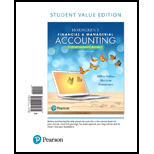
1.
Liabilities
Liabilities are the obligations of the business to pay the creditors and others, towards purchasing goods and services on account, and/or other financial benefits received. Liabilities can be short term (current liability) or long-term depending upon the time it is paid-off. While current liabilities are paid within one year, on the other hand, long-term liabilities are paid over one year period.
Rules of debit and credit:
“An increase in an asset account, an increase in an expense account, a decrease in liability account, and a decrease in a revenue account should be debited.
Similarly, an increase in liability account, an increase in a revenue account and a decrease in an asset account, a decrease in an expenses account should be credited”.
To Journalize: The transaction to record the sale on July 5.
2.
To Journalize: The transaction to record the payment of sales tax to the state.
Want to see the full answer?
Check out a sample textbook solution
Chapter 11 Solutions
Horngren's Financial & Managerial Accounting, The Managerial Chapters, Student Value Edition Plus MyLab Accounting with Pearson eText -- Access Card Package (6th Edition)
- I want the correct answer with accounting questionarrow_forwardA company reports the following financial data: • Sales Revenue: $1,250,000 Average Total Assets (excluding long-term investments): $680,000 Compute the Asset Turnover Ratio. If necessary, round the answer to one decimal place.arrow_forwardwhat is the present value of the notearrow_forward
- Need answerarrow_forwardGarrison Industries produces synthetic rubber used for industrial applications such as conveyor belts. In 2020, the first year of operations, Garrison produced 5,500 tons of rubber and sold 3,200 tons. In 2021, the company produced the same amount of rubber, and sales were 6,500 tons (i.e., the company sold all of its inventory). In each year, the selling price per ton was $2,500, variable manufacturing costs per ton of rubber were $500, and variable selling expenses were $700 for each ton of rubber sold. Fixed manufacturing costs were $5,500,000, and fixed administrative expenses were $650,000. What is the unit manufacturing cost under absorption costing in the year 2021?arrow_forwardGiarrow_forward
- hi tutor provide answer General accountingarrow_forwardHamilton Corp. recently reported an EBITDA of $18.5 million and a net income of $3.6 million. The company had $2.8 million in interest expense, and its corporate tax rate was 35%. Compute Depreciation and Amortization (D&A).arrow_forwardCosts of $9,200 were incurred to acquire goods and make them ready for sale. The goods were shipped to the buyer (FOB shipping point) for a cost of $600. Additional necessary costs of $1,300 were incurred to acquire the goods. What is the buyer's total cost of merchandise inventory?arrow_forward

 AccountingAccountingISBN:9781337272094Author:WARREN, Carl S., Reeve, James M., Duchac, Jonathan E.Publisher:Cengage Learning,
AccountingAccountingISBN:9781337272094Author:WARREN, Carl S., Reeve, James M., Duchac, Jonathan E.Publisher:Cengage Learning, Accounting Information SystemsAccountingISBN:9781337619202Author:Hall, James A.Publisher:Cengage Learning,
Accounting Information SystemsAccountingISBN:9781337619202Author:Hall, James A.Publisher:Cengage Learning, Horngren's Cost Accounting: A Managerial Emphasis...AccountingISBN:9780134475585Author:Srikant M. Datar, Madhav V. RajanPublisher:PEARSON
Horngren's Cost Accounting: A Managerial Emphasis...AccountingISBN:9780134475585Author:Srikant M. Datar, Madhav V. RajanPublisher:PEARSON Intermediate AccountingAccountingISBN:9781259722660Author:J. David Spiceland, Mark W. Nelson, Wayne M ThomasPublisher:McGraw-Hill Education
Intermediate AccountingAccountingISBN:9781259722660Author:J. David Spiceland, Mark W. Nelson, Wayne M ThomasPublisher:McGraw-Hill Education Financial and Managerial AccountingAccountingISBN:9781259726705Author:John J Wild, Ken W. Shaw, Barbara Chiappetta Fundamental Accounting PrinciplesPublisher:McGraw-Hill Education
Financial and Managerial AccountingAccountingISBN:9781259726705Author:John J Wild, Ken W. Shaw, Barbara Chiappetta Fundamental Accounting PrinciplesPublisher:McGraw-Hill Education





